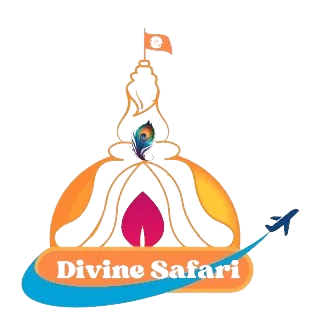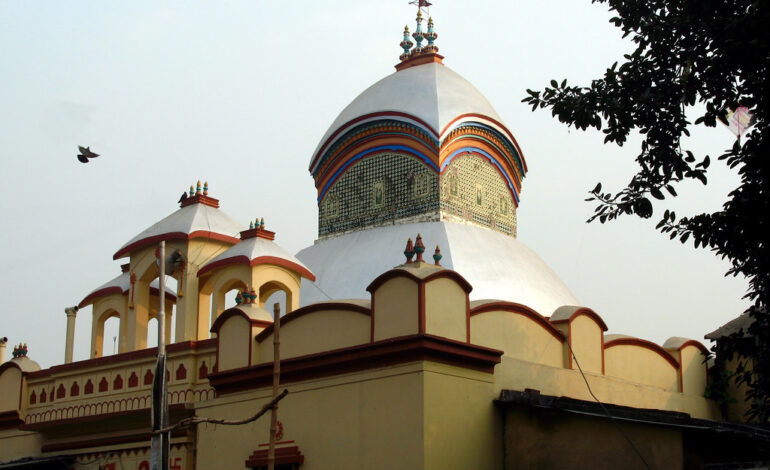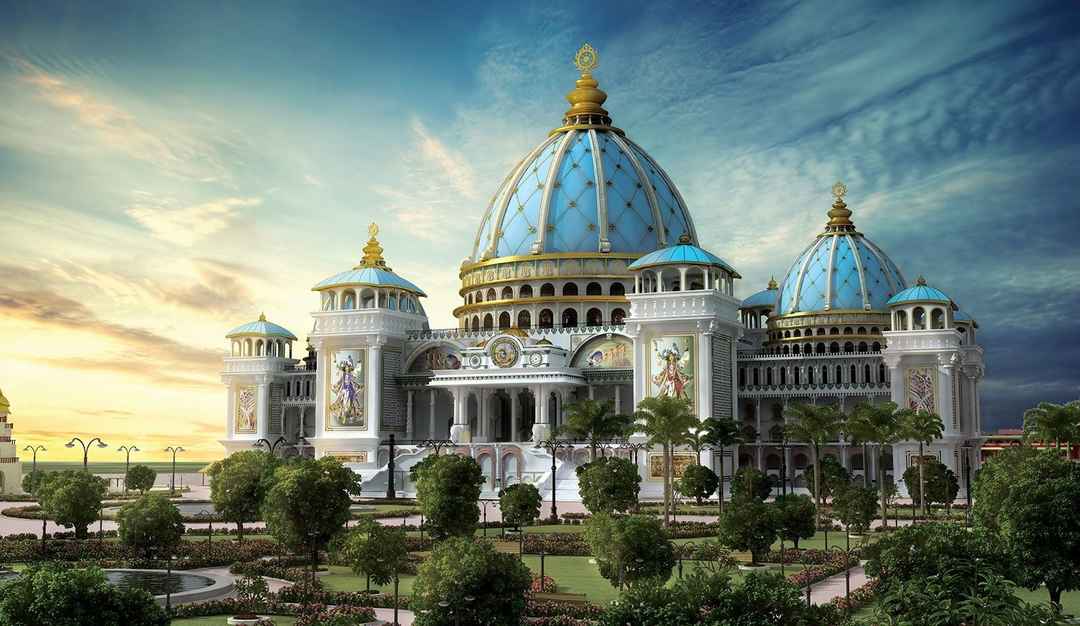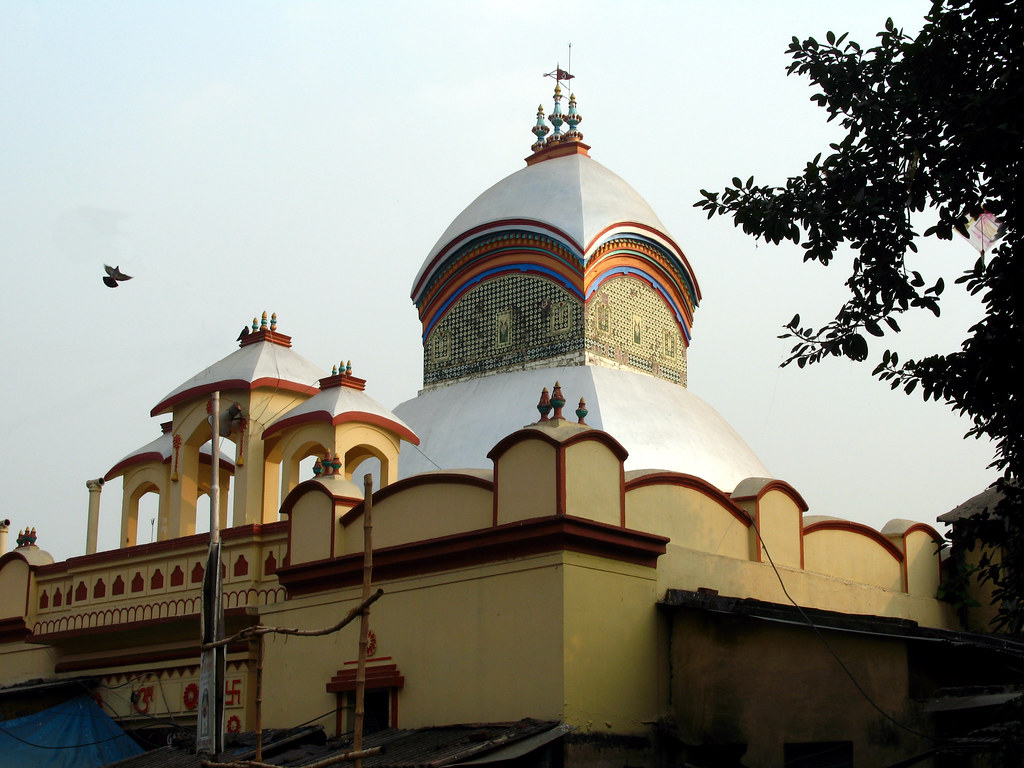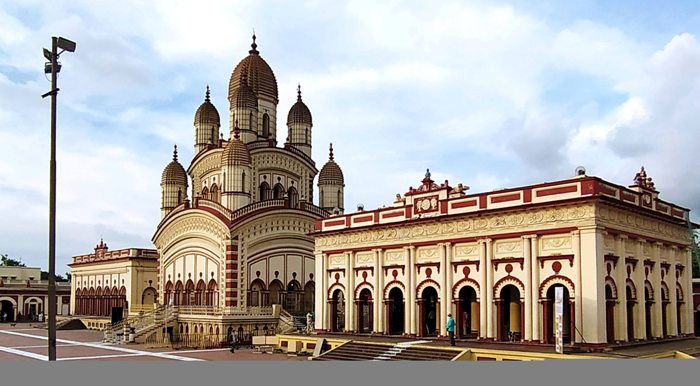
DAKSHINESWAR KALI TEMPLE: A PILGRIMAGE OF PEACE AND DEVOTION
DAKSHINESWAR KALI TEMPLE: A PILGRIMAGE OF PEACE AND DEVOTION
Dakshineswar Kali Temple, also known as “Dakshineswar Kalibari”, stands as a revered Hindu Navaratna Temple in Dakshineswar, Kolkata, West Bengal, India. This temple was constructed in 1855 by the zealous Rani Rashmoni. A devoted follower of Kali Maa, Rashmoni’s visionary dream was to create a space where pilgrims of all castes and religions could offer prayers, fostering unity. This inclusive vision has transformed Dakshineswar into a melting pot of diverse devotees, fulfilling Rashmoni’s dream and creating a serene ambiance. The temple’s universal appeal is heightened by its association with mystic sage Ramakrishna Paramhansa and his wife Sarada Devi, adding a timeless allure to the sanctuary of peace and spiritual harmony. Dedicated to “Maa Bhavatarini”, a divine manifestation of “Parashakti Adya Kali”, the temple is a must-visit site in Kolkata, attracting global visitors with its architectural grandeur and divine aura. Beyond its spiritual significance, Dakshineswar Kali Temple extends intricately weaving into the socio-political history of the region. It underscores multifaceted cultural importance and plays a pivotal role in shaping the enduring legacy of this historical tapestry.
LOCATION
Situated on the eastern bank of the Hooghly River in Dakshineswar, a Kolkata suburb, the revered Dakshineswar Kali Temple is easily accessible from the city center. Dakshineswar, often likened to Varanasi for its religious significance and the flowing Hooghly River, attracts pilgrims and tourists alike. This sacred haven, surrounded by serene gardens, provides respite from urban clamour, offering a tranquil refuge amid the divine aura for seekers on their spiritual journey.
TEMPLE’S TALES
Dakshineswar Kali Temple holds a rich history that intertwines spirituality, social dynamics, and political events. Its foundation in the mid-19th century by Rani Rashmoni marks a significant chapter in Bengal’s cultural and religious narrative. Rani Rashmoni, a Mahishya by caste and a renowned philanthropist, embarked on a pilgrimage to Varanasi in 1847. However, a divine vision of Goddess Kali in a dream altered her plans. The goddess instructed her to build a temple on the banks of the Ganges instead of going to Varanasi. Inspired by this revelation, Rani Rashmoni ardently instructed her trusted associates, particularly her youngest son-in-law, Mathur babu, to seek plots for the construction of a Kali Temple. Following an extensive search, a 20-acre plot in Dakshineswar village was chosen. This plot was shaped like a tortoise’s hump – a symbol resonating with Shakti worship in Tantra traditions. Interestingly, one part of this land was owned by a European Christian, Jake Hastie, and the other a Muslim burial ground.
The construction of this temple complex was started in 1847, and it was completed in eight years with a substantial investment of nine hundred thousand rupees. Central to the complex is a temple venerating Goddess Kali, with twelve Shiva temples (twelve Jyotirlingam), a Vishnu temple, and a Natmandir. The fully realized complex, a testament to unwavering dedication and artistic prowess, stands as a masterpiece. It mirrors the harmonious blend of profound devotion and exquisite craftsmanship within its magnificent design. The spiritual aura it exudes encapsulates the essence of worship, creating a sacred space of unparalleled beauty and transcendence.
On May 31, 1855, the consecration of the Goddess Kali idol marked the temple’s spiritual journey, just preceding the 1857 Sepoy Mutiny. Over one lakh Brahmins were invited nationwide. Ramkumar Chattopadhayay, elder brother of Sri Ramakrishna, served as the head priest. However, following Ramkumar’s untimely death, the responsibility shifted to Ramakrishna, who, over the next thirty years, played a pivotal role in elevating the temple’s fame and attracting pilgrims. Rani Rashmoni’s vision of inclusivity materialized, making Dakshineswar a symbol of religious harmony, attracting millions of devotees from diverse backgrounds.
In the early 19th century, Dakshineswar was a quaint village surrounded by dense forests along the Ganges. The construction of this holy shrine reshaped the landscape and transformed the area into a vibrant hub for spiritual and cultural activities. The Dakshineswar Kali Temple stands as a testament to Rani Rashmoni’s vision, Ramakrishna’s teachings, and the socio-political context of 19th-century Bengal, embodying a rich cultural and spiritual legacy. With architectural grandeur and an inclusive ethos, it attracts pilgrims and visitors, becoming a vital facet of Kolkata’s cultural heritage. Beyond its sacred confines, the temple embodies unity and devotion, transcending religious and societal boundaries, shaping a profound influence in the broader cultural landscape.
DIVINITY IN DESIGN
ARCHITECTURAL SPLENDOR OF DAKSHINESWAR KALI TEMPLE
In addition to its spiritual significance, the Dakshineswar Kali Temple is a reflection of Bengal’s architectural finesse and cultural legacy, drawing devotees, locals, and tourists alike to experience its divine aura and historical charm. The temple, with its intricate design and spiritual ambiance, remains an integral part of Kolkata’s cultural tapestry.
Built in the traditional ‘Nava-Ratna’ or nine spires style, a hallmark of ancient Bengali architecture, this three-storeyed south-facing temple boasts nine spires distributed in the upper two storeys. The entire structure is elevated on a high platform with a flight of stairs, giving the temple an imposing height of over 100 feet and covering an area of approximately 46 square feet. At the heart of the temple lies the Garbha Griha, the sanctum sanctorum, housing the idol of the goddess Kali, known as Bhavatarini. The deity stands on the chest of a reclining Shiva, and both idols rest upon a thousand-petaled lotus crafted from pure silver. The main temple is accompanied by a narrowly covered verandah, serving as an audience chamber, and a spacious Natmandir situated in front of the temple.
Surrounding the central temple, twelve “Aat Chala” style Shiva temples cradle black stone Shivalingas, inspired by the twelve Jyotirlingas. These east-facing sanctuaries served as the meditation grounds of Sri Ramakrishna Paramhansa, believed to have attained enlightenment here. The Vishnu Temple, northeast of the complex, houses a silver throne with idols of Lord Krishna and Radha, where daily puja, once performed by Sri Ramakrishna, takes place. Nearby, the ‘Nahabat’ chamber, in the north-western corner, holds historical significance as Ramakrishna and Maa Sarada’s abode. The vast temple complex attracts thousands of worshippers throughout the year, particularly on significant occasions such as Shyama Puja, Shiva Chaturdashi, Pôila Boishakh, Akshaya Tritiya, New Year’s Day, and Kalpataru Utsava.
IDOL OF SRI SRI JAGADISWARI KALIMATA THAKURANI
Adyashakti, the primal force of energy-consciousness-bliss, embodies Mahamaya, creating and liberating beings from Maya’s grasp. In the celestial battle against Asura brothers Shumbha and Nishumbha, the defeated gods invoked Devi through hymns. Kousiki emerged from Adyashakti’s body, turning Her into Kali or Kalika. In another version, Kali sprung forth during Ambika’s war, originating from her forehead. Kali, the first Vidya of Mahavidyas, wears tigerskin, symbolizing both fierceness and benevolence, embodying various forms—from terrifying to tranquil, she is Mahakali or Kali.
SPIRITUAL GEMS IN AND AROUND THE TEMPLE COMPLEX
Dakshineswar is not merely home to the revered Kali Temple; it also unfolds a rich tapestry of neighbouring sites that deepen the pilgrimage experience, offering glimpses into the spiritual odyssey of Sri Ramakrishna and the historical resonance of the temple’s surroundings.
Nat Mandir: A magnificent 16-pillared structure, “Nat Mandir”, spanning 50 feet by 75 feet, serves as an open hall for religious discourses and spiritual songs. Just above it, an idol of Lord Shiva stands as a witness to the prayers offered by Sri Ramakrishna before entering the Kali Temple. Adjacent to this “Nat Mandir”, a site for religious sacrifices echoes the historical moment when Bhairavi Bramhani Yogeshwari Devi acknowledged Sri Ramakrishna as an avatar.
Nahabat Khana: The Dakshineswar temple complex features two “Nahabat Khanas”. The southern one remains permanently closed, while the second, located west of Kuthi Bari and north of Kali Temple, is still active. Originally hosting various musical instruments, it now exclusively showcases Dhak, Dhol, and Kashi during the Aarti. The room beneath “Nahabat Khana” is Sri Sarada Maa’s former residence, now a site for daily prayers in her honour.
Bakul Tala Ghat: Adjacent to “Nahabat Khana”, “Bakul Tala Ghat” is witness to the sacred bath rituals of Sri Sarada Ma. While the Bakul tree may be absent today, the riverbank serves as a testament to Sri Ramakrishna’s initiation into ‘Tantra Sadhana’ by his guru, Bhairavi Bramhani Yogeshwari Devi.
Chadni: Nestled amidst the twelve Shiva temples on the banks of the Ganges, “Chadni” stands as a sacred space where Sri Totapuri, the Vedantic guru of Sri Ramakrishna, commenced his transformative journey. Ascending a flight of steps leading to this spiritual enclave, one can feel the essence of the revered guru’s arrival and the profound impact it had on the spiritual landscape.
Sri Ramakrishna Thakur’s Room: In the northwest corner of the temple premises, Sri Ramakrishna spent his final 14 years. After dwelling in Kuthi Bari, he shifted during the temple’s renovation. This room hosted the Phalaharini Kali Puja, where he prayed to Sri Sarada Ma as the mother Goddess. It now preserves artefacts, offering a tangible link to his spiritual odyssey.
Kuthi Bari: North of the Ganges, near “Gaji Tala”, “Kuthi Bari”, originally built by Lord Hastings, served as Rani Rashmoni’s retreat. Sri Ramakrishna lived here from 1855 to 1870. Today, it’s a police camp ensuring visitor safety and preserving the historical significance of Rani Rashmoni’s second home, resonating with echoes of the past.
Panchavati: North of “Bakul Tala”, Panchavati unfolds with five trees—Banyan, Peepal, Neem, Amlaki, and Woodapple—planted under Sri Ramakrishna’s guidance. Enriched with soil from Vrindavan’s Radha Kund and Shyam Kund, these trees hold spiritual significance. Here, Sri Ramakrishna dedicated 12 years to Sadhana, took sanyas, and conducted the ‘Annomeru Utsav’ in 1864. The “Sadhana Hut” transformed into “Shanti Kuthi” and a nearby Shiva temple witnesses daily puja.
Gaji Tala: To the northeast of the Kali Temple, “Gaji Tala” stands as a sacred space where Sri Ramakrishna explored Islam. Adjacent to the Ganges, the serene “Gaji Pukur” (pond) mirrors the sky, symbolizing the goddess’s divine attire. Rani Rashmoni, the temple’s founder, consciously preserved “Gaji Tala” as a shared prayer space for Hindus and Muslims. Meticulously maintained by the Debottar Estate, this historic site resonates with spiritual exploration and inclusivity.
RITUALS AND FESTIVALS
Dakshineswar Kali Temple hosts several significant festivals, including Kalpataru on January 1st, drawing fervent devotees. During Navaratri at Dakshineswar Kali Temple, devotees celebrate for nine days. Kumari Puja, honouring young girls, precedes Ayudhya puja on the ninth day, symbolizing hope and joy for livelihood. Dusshera honours Goddess Saraswati, while Diwali witnesses Kali puja, illuminating the temple complex. Monthly rituals like Amavasya and special events like Phalaharini Kali puja in Jaistha contribute to the spiritual vibrancy. The pinnacle is Kali puja during Diwali, attracting numerous pilgrims for tantric and Brahmanical rituals, along with special “Bhog” or “Prasad” distributed to devotees.
TIMINGS OF PROMINENT DAILY EVENTS
Darshan Timings for the Devotees
Mandir remains opened | Timing |
Morning | 06:00 AM to 12:30 PM |
Evening | 15:30 PM to 19:30 AM |
Bhog Timings
Temple Ritual | Monday to Sunday (Timing) |
Bhog | 12:00 Noon |
Note: During festivals, Bhog Timings may change. Tuesdays and weekends are auspicious for Goddess Kali prayers, attracting crowds to the temple. Witnessing the Sandhya Aarti during these bustling days is an essential, enriching experience.
WHY TO VISIT DAKSHINESWAR TEMPLE AT LEAST ONCE
Everyone should visit Dakshineswar Temple at least once for a transformative spiritual experience. Dedicated to Goddess Kali, this holy shrine exudes divine energy. The temple’s architecture and serene surroundings inspire contemplation. Witnessing rituals, especially the evening Aarti, imparts a sense of sacredness. It’s an opportunity to connect with the divine and delve into profound spirituality.
BEST TIME TO VISIT
The best time to visit the temple depends on various factors, including weather conditions, festivals, and personal preferences. Here are some considerations:
- Weather: Kolkata experiences a tropical climate, with hot and humid summers and milder winters. The winter months, from November to February, are generally more comfortable for sightseeing due to cooler temperatures. Avoid the hot and humid summer months, especially from March to June.
- Festivals: The temple attracts a large number of devotees during festivals, especially during Durga Puja, which usually takes place in September or October. This is a grand celebration and a significant time for visiting the temple, but be prepared for larger crowds.
- Weekdays vs. Weekends: If you prefer a quieter and less crowded experience, consider visiting on weekdays rather than weekends.
- Morning or Evening: Early mornings and late evenings are generally more peaceful times to visit religious places. The temperature is milder, and you may find a more serene atmosphere for prayer and contemplation.
- Special Occasions: If you are interested in witnessing special rituals or events at the temple, check the temple calendar for any significant occasions.
HOW TO REACH DAKHINESWAR
Dakshineswar Kali Temple is located in the Dakshineswar town in the northern part of Kolkata, West Bengal, India. Here are the various ways to reach Dakshineswar Kali Temple:
- By Air: Nearest Airport: Netaji Subhas Chandra Bose International Airport (CCU) in Kolkata. From the airport, one can hire a taxi or use other local transportation to reach Dakshineswar. The temple is approximately 12-15 kilometers away from the airport, and the journey takes about 30-45 minutes, depending on traffic conditions.
- By Train: Dakshineswar has its own railway station called Dakshineswar Railway Station. One can take a train to Dakshineswar from Howrah Junction or Sealdah, two major railway stations in Kolkata. The temple is within walking distance from the Dakshineswar Railway Station.
- By Metro: Kolkata Metro services connect various parts of the city, including Dakshineswar. One can take the metro and get off at the Dakshineswar Metro Station, which is close to the temple.
- By Road: Dakshineswar is well-connected by road, and you can use taxis, rickshaws, or other local transport options. Buses also ply to and from Dakshineswar from different parts of Kolkata.
- By Boat: Dakshineswar is situated on the banks of the Hooghly River, and one can also reach the temple by boat. Ferry services are available, especially during festivals and special occasions.
Note:
Always consider the current transportation options and conditions, and it’s a good idea to check for any updates or changes in routes before planning your visit. Local transportation options may vary, and it’s advisable to confirm the most suitable mode of transport based on your location in Kolkata.
